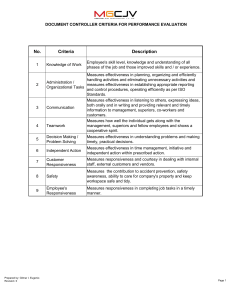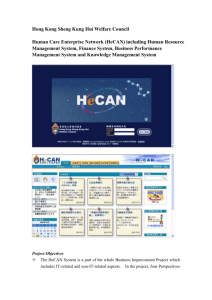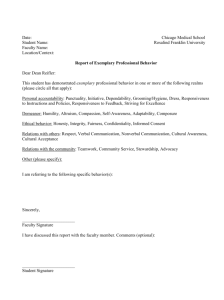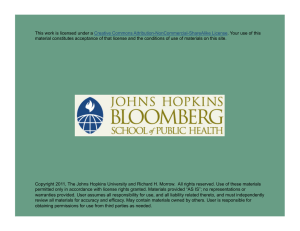Literature review - The Effect of Perceived Partner Responsiveness on General and Personal Well-being in Romantic Relationships
advertisement
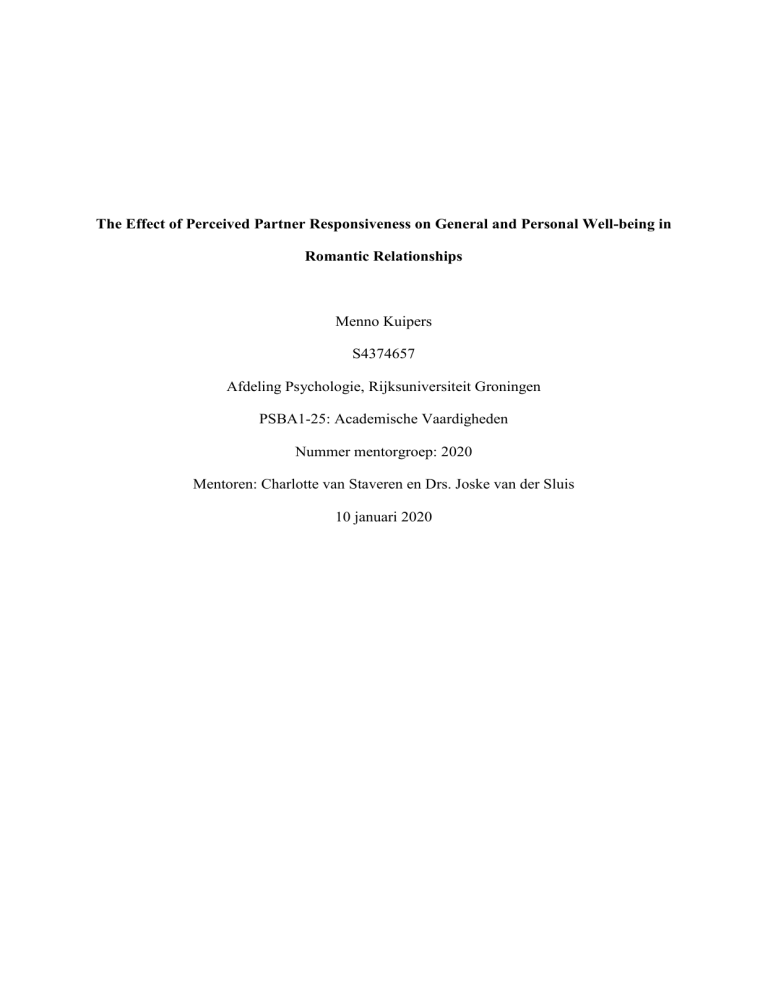
The Effect of Perceived Partner Responsiveness on General and Personal Well-being in Romantic Relationships Menno Kuipers S4374657 Afdeling Psychologie, Rijksuniversiteit Groningen PSBA1-25: Academische Vaardigheden Nummer mentorgroep: 2020 Mentoren: Charlotte van Staveren en Drs. Joske van der Sluis 10 januari 2020 2 The Effect of Perceived Partner Responsiveness on General and Personal Well-being in Romantic Relationships After many years of research on partner support within romantic relationships, and the influence it has on personal well-being, a relatively new idea within the field of relationships has emerged: that of perceived responsiveness. One can speak of perceived responsiveness when an individual perceives responsiveness when his or her partner understands, validates, and cares for the self (Reis, Clark, & Holmes, 2004). The three articles discussed here all – in one way or another - theorize about the positive implications perceived responsiveness might have regarding personal well-being. This development within the science of partner support within romantic relationships must be considered as important as it could well contribute to a better understanding of interpersonal relationships. Maisel and Gabel (2009) conducted a study in which they investigated further upon the findings that, paradoxically, support received from a partner is not always associated with a positive outcome (Kaul & Lakey, 2003). More specifically, they hypothesize that in relationships, perceived support, not actually received support is generally more beneficial, with responsiveness being the crucial and shared factor in both types of support. 67 heterosexual couples completed the study, in which they had to write down daily whether they had shared a negative event outside their relationship with their partner. Their rate of responsiveness was then measured by asking them to rate their agreement with 3 statements on a scale of 1 to 5. These same statements were then asked in regard to their partner, making it possible to find matches between partner reports on responsiveness on a particular day. The results found that on days perceived support occurred, low responsiveness was correlated significantly stronger with anxiety than high responsiveness. Low responsiveness was also correlated with lesser connectedness and feeling of security within the relationship, 3 while high responsiveness was associated with the opposite. The hypothesis was further supported with findings that on days on which both partners reported low responsiveness, reported anxiety affect, relationship connectedness and the feeling of security were worse than on days on which at least one partner reported high responsiveness. Maisel and Gabel found that whether support was visible or invisible did not matter as much as the rate of responsiveness in regard to anxiety affect and relationship quality. One problem I found within the study was the way the comparison category was chosen; namely, the days on which neither partner reported providing support but did report receiving it. The researchers concluded that this had to mean that no negative event was experienced on that day by either partner, thus making it a good comparison category. However, this ignores the possibility that a participant did in fact experience a negative event but did not report it. Dooley et al. (2018) researched the effect of perceived responsiveness on the quality of an often stressful waiting period. They focused on 3 main questions, 2 of which are relevant for the main research question: (a) whether perceived responsiveness changes predictably during the waiting period and (b) whether perceived responsiveness is associated with health and well-being. Regarding question A, research has shown that waiting as an experience is most difficult at the beginning and the end of the waiting period (Howell & Sweeny, 2016; Sweeny & Andrews, 2014; Sweeny et al., 2016). This is why Dooley and colleagues hypothesize that perceived responsiveness must also fluctuate accordingly. Regarding question B, evidence has shown that perceived responsiveness can lower distress and improve one’s physical health and quality of sleep (Selcuk & Ong, 2013; Selcuk et al., 2016). They therefore hypothesize that these findings extend to stressful waiting periods also. The subsample of participants relevant to the study consisted of 168 Law students who reported being in a romantic relationship or having been in one at some point during 4 their study and had to pass the California bar exam. One problem I found was that some of the participants either left or entered a relationship during the study, some of them multiple times, totaling 38 participants. This may have interfered with the quality of the sample. Participants were given 10 surveys, most of which were completed by most participants. Health and well-being as well as the rate of worry and anxiety were measured. Participants were also asked to rate their perception of responsiveness by their partner (if they had one) over the span of a week. Another thing I noticed was that only the exam-takers were surveyed, which meant that the side of their partner had not been taken into consideration at all, something the study by Maisel and Gabel did not lack. Their partner may even have been in a stressful waiting period themselves, too, bringing in a possible third variable. The results found that the participants who talked to a partner did indeed perceive the most responsiveness at the beginning and end of the waiting period. Regarding health and well-being, no association was found between perceived responsiveness and state anxiety or worry. However, a positive correlation was found between perceived responsiveness and positive emotion, as well as quality of sleep. Tasfiliz et al. (2018) note that the influence of perceived responsiveness in romantic relationships has been researched quite well, but that the studies have almost all been conducted in western culture, disregarding the possible cross-cultural differences, which is what they are interested in in this paper. Two types of well-being are taken into account: heudonic and eudaimonic health; the former regarding general satisfaction with life, and the latter having to do more with the extent to which one’s potential is being used, and whether one has meaning and purpose in life. It is then hypothesized that in the U.S., eudaimonic health is associated with perceived partner responsiveness. Tasfiliz et al. analyze data from the U.S. and Japan; the choice of the countries researched are explained by the difference in the self-construals, more specifically, people in the U.S. are generally believed to have 5 independent self-construals, while the Japanese are believed to have interdependent selfconstruals, which means the self is secondary to relational connections (Adams, Anderson, & Adonu, 2004; Markus & Kitayama, 2010). It is then hypothesized that perceived responsiveness is a better predictor of well-being in the U.S. than in Japan. Two large surveys, one, the MIDUS from the U.S., conducted in 2004-2006, and one from Japan, the MIDJA conducted in 2008-2010, were used and analyzed. One thing I noticed was that the MIDJA study only consisted of people from the Tokyo Metropolitan area, which might have negative implications for the external validity of the findings. Perceived well-being and well-being (both hedonic and eudaimonic) were surveyed. Results indicated that perceived responsiveness was a predictor for both hedonic and eudaimonic well-being, in both countries. However, this association was stronger in the U.S. than in Japan. Regarding the differences between hedonic and eudaimonic well-being and the association of both with perceived responsiveness, the results showed that eudaimonic wellbeing was associated strongest with perceived responsiveness over hedonic well-being. It did bother me that the results are still not fully generalizable to other parts of the world, as only the U.S. and Japan have now been compared. This makes it a great opportunity for future research. The question is whether perceived responsiveness is associated with general and personal well-being in relationships. From the 3 articles discussed, we can deduct that perceived responsiveness absolutely is an important factor in romantic relationships. Maisel and Gaibel found that whether the support given is actually given or not does not really matter in the end, but perceived responsiveness does and is the deciding factor. Dooley et al. found that during a stressful waiting period, perceived responsiveness could benefit overall perceived health, emotional well-being and sleep quality. Tazfiliz et al. found that these findings do not only generalize to western society, but to the Asian world as well. A few 6 problems concerning validity were found, in the paper by Dooley et al., as well as Tazfiliz et al. It is clear that further research needs to be done on this topic, as it is a relatively new one. 7 References Adams, G., Anderson, S. L., & Adonu, J. K. (2004). The cultural grounding of closeness and intimacy. In D. J. Mashek & A. Aron (Eds.), The handbook of closeness and intimacy (pp. 321–339). Mahwah, NJ: Lawrence Erlbaum. Dooley, M. K., Sweeny, K., Howell, J. L., & Reynolds, C. A. (2018). Perceptions of romantic partners’ responsiveness during a period of stressful uncertainty. Journal of Personality and Social Psychology, 115(4), 677–687. https://doi.org/10.1037/pspi0000134 Maisel, N. C., & Gable, S. L. (2009). The paradox of received social support. The importance of responsiveness. Psychological Science, 20(8), 928-932. https://doi.org/10.1111/j.1467-9280.2009.02388.x Howell, J. L., & Sweeny, K. (2016). Is waiting bad for subjective health? Journal of Behavioral Medicine, 39, 652–664. http://dx.doi.org/10 .1007/s10865-016-9729-7 Kaul, M., & Lakey, B. (2003). Where is the support in perceived support? The role of generic relationship satisfaction and enacted support in perceived support’s relation to low distress. Journal of Social & Clinical Psychology, 22, 59–78. https://doi.org/10.1521/jscp.22.1.59.22761 Selcuk, E., & Ong, A. D. (2013). Perceived partner responsiveness mod- erates the association between received emotional support and all-cause mortality. Health Psychology, 32, 231–235. http://dx.doi.org/10.1037/a0028276 Selcuk, E., Stanton, S. C., Slatcher, R. B., & Ong, A. D. (2016). Perceived partner responsiveness predicts better sleep quality through lower anxiety. Social Psychologial & Personality Science, 8, 83–92. http://dx.doi.org.proxyub.rug.nl/10.1177/1948550616662128 8 Sweeny, K., & Andrews, S. E. (2014). Mapping individual differences in the experience of a waiting period. Journal of Personality and Social Psychology, 106, 1015–1030. http://dx.doi.org/10.1037/a0036031 Sweeny, K., Reynolds, C. A., Falkenstein, A., Andrews, S. E., & Dooley, M. D. (2016). Two definitions of waiting well. Emotion, 16, 129–143. http://dx.doi.org/10.1037/emo0000117 Markus, H. R., & Kitayama, S. (2010). Cultures and selves: A cycle of mutual constitution. Perspectives on Psychological Science, 5, 420– 430. http://dx.doi.org/10.1177/1745691610375557 Reis, H.T., Clark, M.S., & Holmes, J.G. (2004). Perceived partner responsiveness as an organizing construct in the study of intimacy and closeness. In D.J. Mashek (Ed.), Handbook of closeness and intimacy (pp. 201–225). Mahwah, NJ: Erlbaum. Tasfliz, D., Selcuk, E., Gunaydin, G., Slatcher, R. B., Corriero, E., & Ong, A. D. (2018). Patterns of partner responsiveness and well-being in Japan and the United States. Journal of Family Psychology, 32(3), 355-365. https://doi.org/10.1037/fam0000378 9
